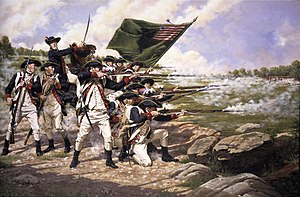
Compared to the massive casualties sustained during the American Civil War, relatively few soldiers died in battle during the American Revolution. The reason for this disparity is in the technology and military tactics of the day. The Battle of Long Island, August 26th 1776, lasted just over four hours, and it is amazing that the huge weight of lead fired between the opposing forces proportionally hit so few men. However, when considering the limitations the of the musket in use at the time, the results are more easily understood.
At Gowanus Bay, American Generals Stirling, Parsons, and Atlee faced the portly British General Grant. There was a continuous fire that ultimately exhausted Grant’s supply of ammunition (though the initial intent of Grant was to hold the American forces until General Howe’s main force could get to the American rear). The distance between the two forces was not much less than 125 yards, at its closest, ranging 300 to 600 yards on average. Muskets were entirely ineffective at that range. The British musket’s ultimate lethal range was about 125 yards, at which point the ball would literally fall to the ground. Major George Hanger, an eighteenth century authority on arms, stated, “a soldier’s musket, if not exceedingly ill bored (as many of them are) will strike … a man at eighty yards; it may even at a hundred. But a soldier must be very unfortunate indeed who shall be wounded by a common musket at 150 yards; and as to firing at a man at two hundred yards, you might as well fire at the moon.” Since many of the rebel forces carried English Brown Bess’s ( Stirling’s Delawares were all armed with fine English muskets as were many of the Marylanders who fought beside them) the two sides were evenly matched.

Besides the limitations of the musket itself, the soldier’s abilities must be considered. The British soldier was no marksman. Many had rarely even fired a gun before being thrust into battle. Musketry and fowling pieces were reserved for English gentry who hunted in social events on lavish country estates. The common Englishman did not fire a gun nor even owned one. When recruited for the crown’s Magisterial Forces, he was never taught to aim, neither at a single person nor at a grouping of the enemy. He was told to “point it – not sight it – toward the enemy and, at the command to fire, pull the trigger.” In fact, the musket, using only one site near the muzzle, was not designed for accuracy. As historian George Trevelyan, points out, “He was taught to point his weapon horizontally, brace himself for a vicious recoil, and pull a ten-pound trigger till his gun went off; if, indeed, it did go off when the hammer fell.” Because of the vicious recoil most of the British shot went high. Though Americans were better ‘shots’ than their British counterparts, most who owned weapons were mostly ineffective during massed infantry attack, outside of the few frontiersmen who carried rifles.
The accepted 18th century tactic was to fire the musket in massed volleys as a prelude to a charge with the bayonet. The bayonet, a sharp affixed blade fourteen to eighteen inches in length was considered the weapon of choice by most officers. The British ranks would march in order to close with their enemy to within 100 yards. After one or two volleys, leaders relied on the massed concentration of disciplined men, terrifying in their brilliant uniforms, to charge with bayonets. The charge was meant to strike fear into the adversary and put him to flight. During the Battle of Long Island, most American soldiers did not carry bayonets, with the exception of Haslet’s Delawares. Early in the war, when the British charged, the Americans fell back. Later on, when the Americans adopted standard military tactics, they relied heavily on defensive breastworks to hold their lines, a tactic which sometimes proved more effective at inflicting casualties on the attacking force, as seen at the Battle of Bunker Hill.
Want to Learn More? Check out these Free Previews of Great Books on Amazon
Check out these informative articles on the usage and History of Muskets and Rifles in the Revolutionary War Journal
Shades of Liberty is the exciting new action-packed series that chronicles African Americans who fought in the American Revolutionary War.
RESOURCES
Fleming, Thomas J. Now We are Enemies, The Story of Bunker Hill. 1960: St. Martin’s Press, New York, NY.
Trevelyan, Sir George O. The American Revolution. 6 vols. 1912: Logman’s Green and Co., London, NY.
Ward, Christopher. The War of the Revolution. 1941: Reprinted 2011 by Skyhorse Publishing, New York, NY.





